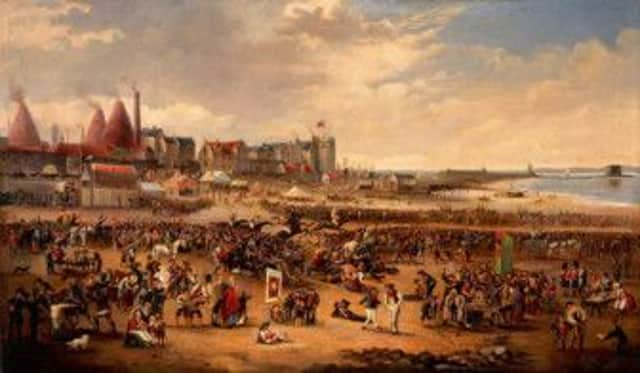Lost Edinburgh: Leith Races


Beginnings
The Leith Races took place on a long strip of beach known as Leith Sands to the east of the harbour, and eventually became a long-running annual fixture.
Horse racing at Leith first began in the early 1500s. The 1504 accounts of James IV make reference to a payment to “the boy who ran the King’s horse” at Leith.
Advertisement
Hide AdBy the 1760s, the Leith Races were recognised as one of the most hotly anticipated fixtures in the Scottish sporting calendar, and attracted great crowds of people from up and down the country. Each July or August, Leith and Edinburgh were propelled into ‘a state of feverish excitation’ with many businesses closing up shop for the duration. The town of Leith, with its famous golfing links, bowling green and annual horse racing events, was arguably the sporting epicentre of Scotland at this time.
Race week
As the race week was run by the town council, a uniformed city officer marched to the Races every morning, “bearing aloft at the end of a long pole the gaily ornamented city purse”. The race-goers walked with him down Leith Walk so that he “disappeared amidst the moving myriads, until only the purse at the end of the pole revealed his presence”.
Great care was taken to have the sands measured off and in good order for the horses, and proclamations were issued prohibiting digging for bait, for example, until the Races were over.
Prizes
Prizes included the City of Edinburgh purse of £50, His Majesty’s purse of 100 guineas and the Ladies Subscription of 50 guineas. On the last day of the meeting, there was a purse for the horses beaten in the earlier part of the week.
In 1738-39, the top prize was an exquisite golden teapot, “the King’s prize”. You can find it today on display at the National Museum of Scotland.
Drinking and fighting
The racing seems to have been subsidiary to other activities on the sands. These included shows, wheels of fortune and refreshment at the “vast lines of drinking booths which stretched along the shore”. For an entire week, the town was “one continued scene of racing, drinking and fighting”.
Advertisement
Hide AdOn the final day of the races, a fighting match would often break out among those who were still able. The entire length of Leith Walk is said to have descended into chaos, with mass brawls breaking out among the drunken crowds on their return back up to Edinburgh.
Transfer to Musselburgh and demise
In 1816 the annual races were transferred to the smooth turf of nearby Musselburgh, where they have remained. Subscription races did continue at Leith Sands up until 1859, but a banning order on the sale of “spirituous liquor” on the day of the event helped to prevent the havoc of yesteryear.
Advertisement
Hide AdAfter the demise of the races, Leith Sands was incorporated into the ever-expanding dock area.
Musselburgh Racecourse continues to operate today, with horse racing just as popular now as it was in the days of the Leith Races. Thankfully, the widespread drunkenness and violence appear to have been ditched in the 19th century.